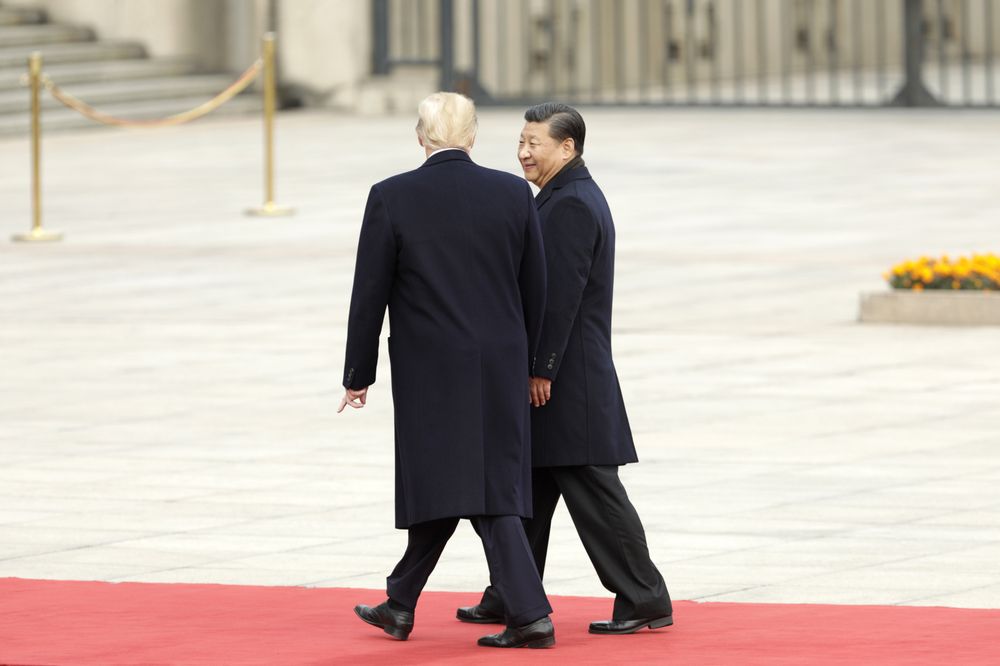
Bloomberg reports that President Donald Trump often seems to be caught between his ideological desire to rewrite America's trade relationship with China and a businessman's instinct to cut a deal. And with midterm elections looming and financial markets coming off a rough October, the deal-maker appears to have the upper hand. "We'll make a deal with China, and I think it will be a very fair deal for everybody," Trump told reporters on Friday after asking aides the day before to begin drafting ideas for an agreement to take to his planned meeting with Chinese President Xi Jinping at the Group of 20 summit in Argentina Nov. 30 to Dec. 1. The two sides are "getting much closer to doing something," he said.Still, to satisfy Trump's own inner ideologue -- and the China hawks in his administration -- that "something" is going to have to hang on substance. And that's where things are likely to get complicated. Xi may fill out the picture on Monday when he is due to address a trade fair in Shanghai. Analysts familiar with White House discussions, however, say any deal struck at the G-20 is likely to take the form more of a temporary truce than anything that will bring a final peace in the trade wars. Such a ceasefire could, they said, see a commitment to forgo additional tariffs, and possibly even to remove some, while high-level officials negotiate a broader pact.
CNN reports that the US Navy has had 18 unsafe or unprofessional encounters with Chinese military forces in the Pacific since 2016, according to US military statistics obtained by CNN. "We have found records of 19 unsafe and/or unprofessional interactions with China and Russia since 2016 (18 with China and one with Russia)," Cmdr. Nate Christensen, a spokesman for the US Pacific Fleet, told CNN. A US official familiar with the statistics told CNN that 2017, the first year of the Trump administration, saw the most unsafe and or unprofessional encounters with Chinese forces during the period. At least three of those incidents took place in February, May and July of that year and involved Chinese fighter jets making what the US considered to be "unsafe" intercepts of Navy surveillance planes. While the 18 recorded incidents only involved US naval forces, the Air Force has also had at least one such encounter during this period.
- 2018-11-02 Trump and China’s Xi give positive signs over phone call but markets give up early gains
- 2018-11-01 Australia to Rebuild U.S. World War II Base as China Courts Pacific Allies
- 2018-10-31 Taiwan's UMC halts R&D activities with Chinese semiconductor firm after U.S. ban
- 2018-10-30 China's currency just hit its lowest level in a decade. What's next?
- 2018-10-29 China takes another big step to open its financial markets
- 2018-10-28 Ceasefire in trade war with China bodes well for American business
- 2018-10-26 Shinzo Abe Says Japan Is China’s ‘Partner,’ and No Longer Its Aid Donor
- 2018-10-25 China Mocks Report It Tapped Trump’s iPhone (and Plugs Its Own Competitor)
- 2018-10-24 Japan and China, Asian Rivals, Are Trying to Get Along
- 2018-10-23 China Officially Launched the World's Longest Sea Bridge Linking Hong Kong and Macau to the Mainland
- Bloomberg Xi to Face World Tired of Empty Promises at Big China Trade Fair
- Bloomberg The $6 Trillion Barrier Holding Electric Cars Back
- Bloomberg Default Risks Rise in $355 Billion China Property Bond Market
- Reuters Activists urge deep scrutiny of China at UN rights gathering this week
- Forbes Chinese Tech Giant Meituan Focuses On A "Food Plus" Super App To Up The Ante With Alibaba
- Financial Times China student speaks of harassment over protests
- Reuters Trade war, spy claims cloud horizon for China airshow
- New York Times More Evidence Points to China as Source of Ozone-Depleting Gas
- CNN China's middle class: We're being picked like leeks by the government
- CNN Truck crash, other accidents leave more than 20 dead in China
- Financial Times China pledges economic aid for Pakistan — but not yet
- Wall Street Journal China to Tighten Rules on Five Financial Giants
- Wall Street Journal 'Kind of Like the NBA': Esports Mount Full-Court Press in China
- uk.reuters.com US carrier leads warships in biggest ever Japan defence war game
- The Washington Post China says willing to help Pakistan over fiscal crisis
- mobile.reuters.com China, US, signal trade war detente
- The Guardian Experts fear impact of China lifting trade ban on tiger and rhino parts
